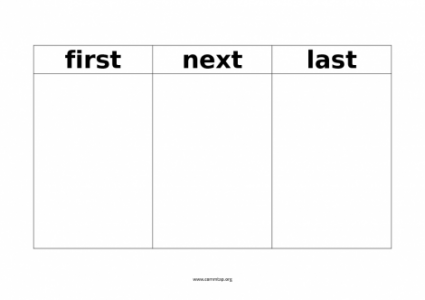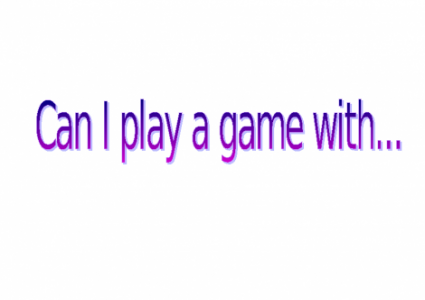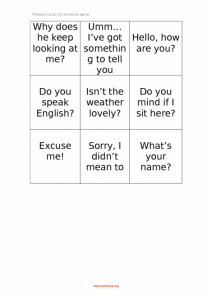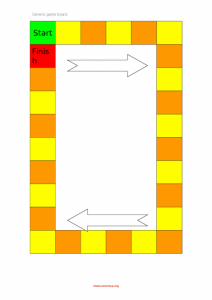Search
User login
Topic “Individual”
Contains activities for individuals (one on one).
think and talk about events in the past and future
| Activity/strategy name and materials required | How to do the activity | Key principles for doing the activity and comments |
|---|---|---|
| Which day? Sheet of paper with 3 boxes drawn on them for yesterday, today and tomorrow. A counter. Optional: sets of symbol cards or pictures showing a variety of activities - including activities the student may have done. You can create symbols cards using the Commtap Symboliser for PowerPoint. | 1. Talk about each day, one at a time. Get the student to draw or write things they have done or will do in each box. Use the picture symbols if the student is having difficulty coming up with things. 2. When you have finished, explain that there is going to be a quiz. Describe an activity and the student must say if they did it yesterday, did it today or will do it tomorrow. 3. Have them step the counter over onto the right day. | This works best when there are key things which are different about each day! |
| The Story of Fred Set of three pictures - one showing a picture of a child, one showing a picture (preferably of the same person!) at a similar age to the student and one a picture of an older person. These could be photographs or drawings. Choose three ages which are appropriate/relevant for the student.
Large 'thought clouds ' on A3 or A4 paper: Sticky tape Pens Picture symbol prompts if required. You can create symbol prompts using the Commtap Symboliser for PowerPoint. | ||
| Calendar Calendar Pens | This is an ongoing activity. You could take photos of the key events, and put them on the calendar. | |
| Daily Schedule/Picture Schedule Any activity or set of activities where the student might use a schedule or have a visual timetable. You can create a visual timetable/schedule using the Commtap Symboliser for PowerPoint. |
Sequence three pictures related to hygiene
| Activity/strategy name and materials required | How to do the activity | Key principles for doing the activity and comments |
|---|---|---|
| Self Care Activities Camera to make the picture sequences (or alternatively you can draw them or use a commercial resource). Resources as appropriate to carry out a simple sequence Examples of sequences: Clean teeth: get toothpaste, open lid, get brush, squeeze toothpaste onto brush, put lid back onto toothpaste, brush teeth, spit out, put brush under water, repeat, clean brush, put brush away. Wash hands: turn on tap, rinse hands, put soap on hands, scrub hands, rinse under water, turn tap off, dry with towel. Brush hair: get brush, brush hair, put brush away. Deodorant: get deodorant, take off lid, spray at appropriate area, put lid back on, put away. | 1. Carry out the sequence without the pictures; 2. Do it again, showing the relevant picture for each part of the activity as you do it; 3. Get the student to do the sequence, showing them a picture for each part of the sequence as they do it; 4. Get them to show you what to do by giving you a picture for each part of the sequence. Try to do exactly as the picture you are given indicates, for example if they give you a picture of scrubbing your hands before the tap is turned on/before you have the soap, try to do this - but appear confused when this doesn't work. | At this level students may often be able to learn particular sequences of pictures without understanding that they relate to a sequence of actions, these activities are designed to address this issue. Seeing how the sequence goes wrong if the wrong picture is chosen (in step 4) will encourage the student to work out which should have been the right picture without you needing to give any further feedback. |
Developing turn taking using sensory toys
| Activity/strategy name and materials required | How to do the activity | Key principles for doing the activity and comments |
|---|---|---|
| Sensory Suitcase Use a small box or bag to collect toys which target different sensory areas e.g. Auditory (noisy toys) toys (rattles, squeakers, shakers, musical items, drums etc.) Visual toys (flags, streamers, Slinkies, spinners, bubbles, flashing items, torches, pop-up toys, windmills etc.) Tactile toys (toys that feel different) (balls of different textures to squeeze, brushes of different textures to be tickled with, materials e.g. velvet, sandpaper, feathers, pots of rice/macaroni to feel, Play dough to squeeze/cut ) Scented toys (play dough, Plasticine, some rubber toys) | 1. Collect some toys from each of the sensory categories described. 2. Store the toys in a container which you use only for this specific activity and is otherwise stored away from children. 3. Find a quiet comfortable place to work either at a table or on the floor. Try to make sure the child cannot easily run off or get distracted. 4. Make a show of shaking the suitcase and seeming happy about the approaching activity. 5. Take out two toys from different sensory categories and place them in front of the child - note which category of item the child chooses/reaches for and put the other item back in the suitcase. 6. Allow the child a short time to enjoy the item chosen then say 'Your name's turn' (e.g. "Mary's turn") and gently but firmly take the item for your turn. 7. Use the toy for a short time then offer it the child again. Say 'Child's name's turn'. 8. Repeat a few times but stop before the child gets bored. 9. Start the process again by offering the child a choice of toys from two different sensory categories and then follow the turn taking routine. 10. Continue with the activity for approximately 10 minutes - stop before the child gets bored. 11. Store the sensory suitcase in a secure place until the next session.
| These activities are based on a child's sensory preferences. Some children love visual toys but are frightened of noisy (auditory) toys. Accept these preferences and work with the sensory areas the child is comfortable with. Some children will choose some kinds of noisy toys and reject others or show fear when presented with others. Some children are frightened of feathers but love being tickled with a shaving brush. Experiment and observe! Sensory preferences can change over time as well! Keep the activity fun and show that you are enjoying it too! Make the activity time limited so that it stays special. Do the activity regularly and change the items used from time to time. |
| Create Colourful Patterns Use a selection of the following: Paint pots and brushes, felt tips, computer painting programme, pots with different coloured bits of paper to stick and a sheet of paper. | ||
| Messy Play Use, for example, one of the following sets of items: Sand tray with spades, pots etc. Water tray with pots, sieves, pourers etc Rice tray with pots and pourers etc |
Think through more complex social situations
| Activity/strategy name and materials required | How to do the activity | Key principles for doing the activity and comments |
|---|---|---|
| Newspaper Newspaper or children's paper or magazine Large sheet of paper Pens | Choose a page of a newspaper or children's paper, or cut out some stories from a newspaper. (You could also do this on line if you have access to a computer. It is very motivating for the children!) Choose stories that will prompt discussion and are not simple right / wrong issues. Put the main person in the story in a circle in the middle of a page. Draw lots of lines out of the circle, and think of different things the person could do. Have each child circle the one they think they would suggest . Help the children think about what will happen if the person takes their advice. | |
| You're in charge! Cards to write situations on. Paper Pens | ||
| Freeze frames Short video clips from children's programmes | You could write individual or group letters to the programme makers suggesting an ending to this scene. | |
| Alien bluff Alien puppet or picture. Cards to write situations on. Everyday situations at school and home. | Use a variety of situations - in class, in whole school events, in the playground, at home, etc. | |
| Social Sequences LDA what's wrong social sequencing cards. Paper or whiteboard Pens | Use paper or a white board to keep the discussion focused. Use facial emotions cards as visual prompts to help the children think about what people are feeling and why. |
Name common objects
| Activity/strategy name and materials required | How to do the activity | Key principles for doing the activity and comments |
|---|---|---|
| Story books and pictures | Describe and look for things and actions in story books and pictures. | |
| Fishing game pictures with paper clips attached, magnetic fishing rods, 'pond' e.g. a flat box | Put cards in the box, take turns to fish for a picture, say/sign what is fished out. | Give the pupil time to name the object. Help them by giving a prompt (e.g. a forced alternative, the first sound. or the word or sign to repeat) |
| 'Hide the fish' Eight picture cards, small piece of paper with a fish drawn on it | ||
| Collages Pictures of everyday objects, background pictures (Black Sheep Sentence Builder and Narrative Packs have some good ones) | Give the pupil time to name the object. Help them by giving a prompt (e.g. a forced alternative, the first sound. or the word or sign to repeat) Have each child take a turn at thinking of other items they could add to that collage. They can draw these on. | |
| Jotters Pictures of everyday objects from class and outside. A blank jotter book | Have the child take a turn at thinking of other items they could add | |
| Odd one out activites Pictures of everyday objects from class and outside | Give the pupil time to think about it. Help them by giving a prompt (e.g. a forced alternative, talking about where you find each object and what you do with it.) |
Starts to greet familiar people using a reward chart system
| Activity/strategy name and materials required | How to do the activity | Key principles for doing the activity and comments |
|---|---|---|
| Says ‘Hello’ to 3 familiar people
If you don't already have a symbol for "hello" you can find one in the Commtap Symboliser.
|
| The length of these instructions show that this is quite a difficult routine to learn! The object of the activity is give the child conventional politeness. Allow time to develop this skill.
|
Use "is" to join a noun to an adjective
| Activity/strategy name and materials required | How to do the activity | Key principles for doing the activity and comments |
|---|---|---|
| Sentence Sequencing cards Cards showing a range of nouns and adjectives plus the words "the" and "is". DLTK's examples. (https://www.dltk-kids.com/) Pencil and paper (optional) | 1. Lay the word "is" on the table in front of the child. Put the word "the" to the left of this, with a gap in between them. Check that the child can read both words; 2. Put one of the noun cards into the gap between the words "the" and "is"; 3. Put one of the adjective cards after the word "is"; 4. Read the sentence to the child (e.g. "the monster is green"); 5. Encourage the child to make up new sentences in the same manner. It doesn't matter if the sentences are silly; 6. You can use the paper to record the sentences made, or for the child to draw an appropriate picture on. | Only suitable for children who can read simple single words. |
| What's in the bag? Feely bag containing a range of objects (choose objects appropriate for the children you are working with); "is" cue card as previous activity. |
To make eye contact
| Activity/strategy name and materials required | How to do the activity | Key principles for doing the activity and comments |
|---|---|---|
| Gain visual attention Use something that the person may be visually attracted by, for example:
|
| Remember that although the room needs to have little visual distraction the light needs to be sufficient to allow clear eye contact to be made e.g. a low light sensory room may not be so good for this activity. |
Able to play simple action games and respond to greetings
| Activity/strategy name and materials required | How to do the activity | Key principles for doing the activity and comments |
|---|---|---|
| Playing action games Action toys Action nursery rhymes | 1. Use any toy which you need to post or press a key or push a part to make something happen e.g. rolling marbles down a kitchen roll holder, catching fish with a magnet and putting into a pond, press a button and the toy pops up. Set the toy up and take turns to have a go. 2. Play round and round the garden type games. Start the game and pause before the exciting end part and wait for the child to indicate he/she wants you to continue by the child looking at you or moving your hand to show he/she wants more. | Child learns to take turns Child accepts ending and starting a turn |
| Child says bye. | Be consistent in the ritual. The only thing that varies is the names of the people involved. | |
| Child greets familiar adults Soft toys | ||
| Child sits in a small group for story time. Comfy bean bags and favourite book |
First next last; first last templates
Template to use for first/next/last or first/last sequencing - with space for pictures. Example activities: sequences three pictures with first next and last.
Created 18 October 2012; updated 19 July 2015.
Initiation prompt cards
Examples of prompt cards you could use to help a child initiate - includes the main part of a sentence which the child may need to fill in using a name. Example activity.
Created 18 October 2012; updated 8 December 2015.
Robert's Friend
One day there was a boy called Robert. He was starting at a new school. On his first day, he met lots of children in his class. At playtime, he went outside with everyone else. Some children played football. Some children played hopscotch. Some children ran around and played tag. Robert wished he could play. He didn’t know anybody yet.
Phrases cards for emotions game
Created 18 October 2012; updated 30 April 2022.
Generic game track
A coloured track which, along with dice and counters for example, could be used to make a variety of activities into a game - for example, shake the dice, move the counter, and if you land on an orange square, pick a card and describe what is on it.
Created 18 October 2012; updated 19 July 2015.
Support Commtap to keep it online
Thank you for visiting Commtap.
Please read this message as it is extremely important.
- Visitor donations mean we can continue to host over 1,000 free activities to support speech, language, and communication development.
- Visitor donations mean we can continue to provide free resources to address a wide range of communication needs, including limited speech or language, interaction challenges, and needs associated with conditions such as developmental language disorder, autism, and cerebral palsy.
- Visitor donations mean we can continue to provide resources to support the work of speech and language therapists, teachers, teaching assistants, parents, and carers.
- Visitor donations mean we can continue to provide the free key word sign dictionary (bks.org.uk) which has over 2,000 Makaton and Signalong signs.
We know that not everyone is able to afford to pay to access these resources, however, if you can, please make a donation to keep the site going.
Thank you
Google ads on this page are provided by Google Adsense - and their presence does not imply any endorsement by Commtap. Report a problem with an ad on this page. Log in (for free) to avoid seeing Google ads.







